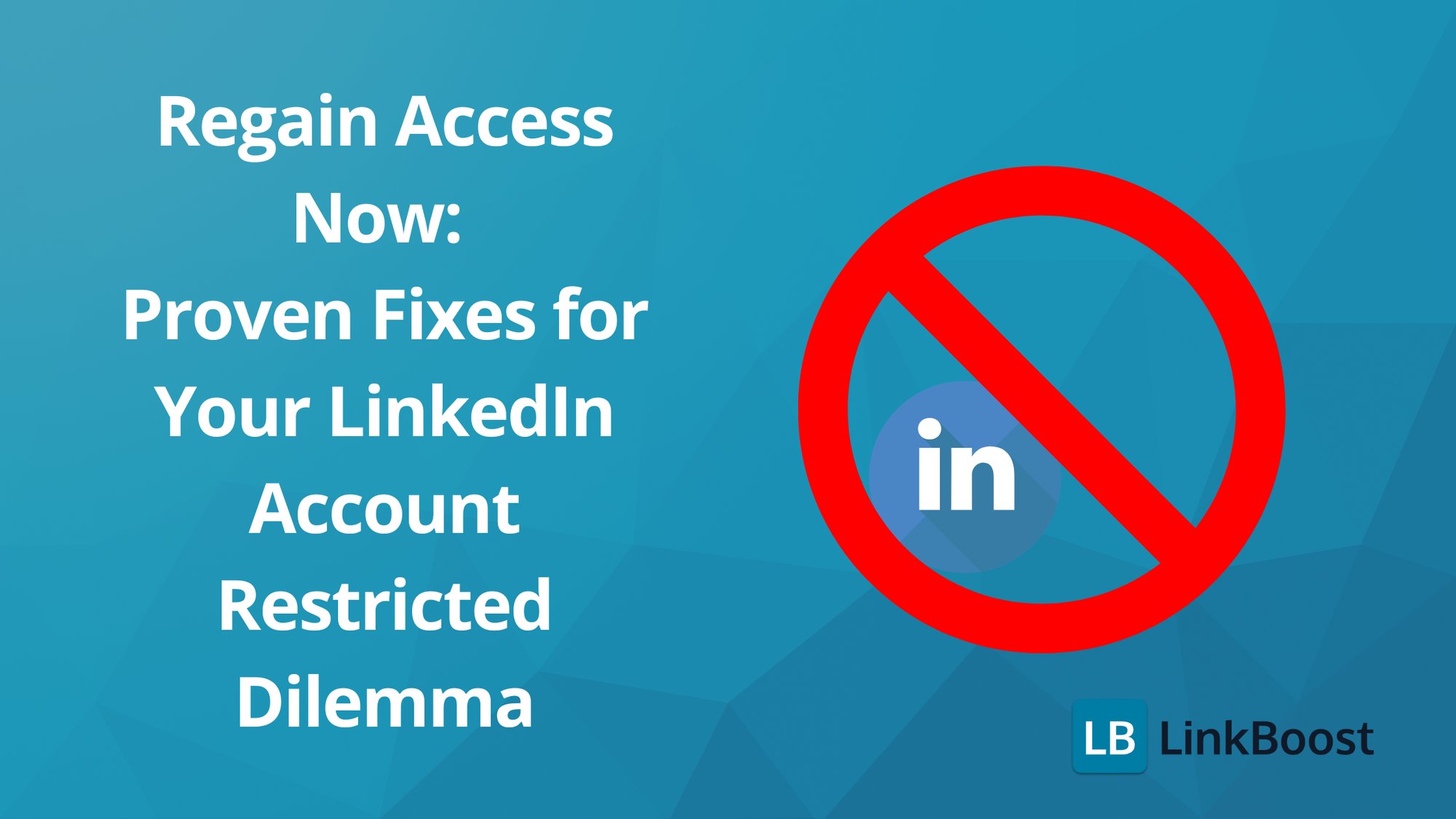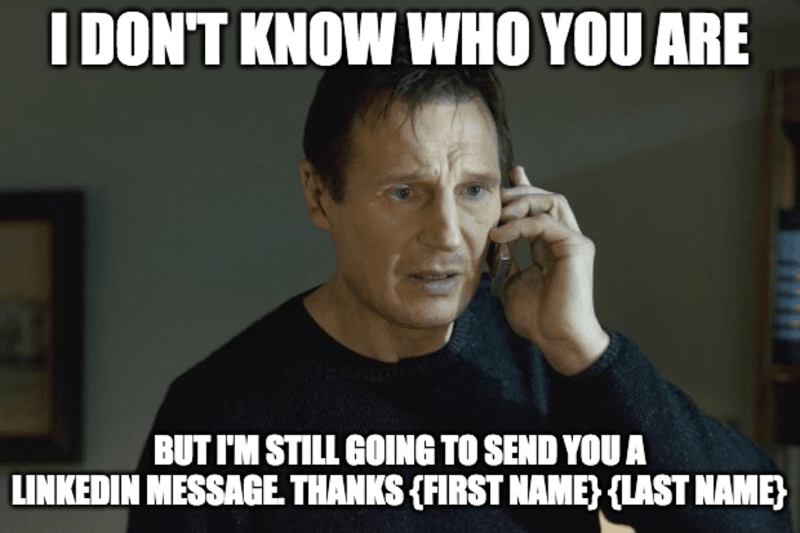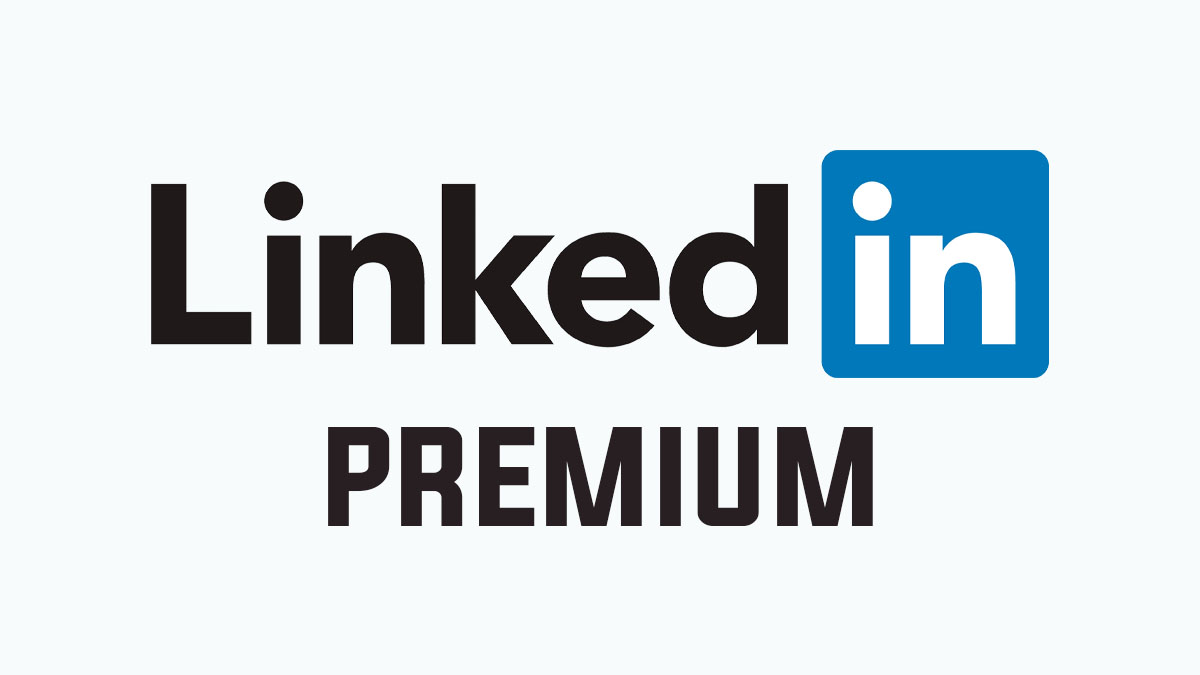My LinkedIn Account is Temporarily Restricted: Proven Fixes for Your Dilemma

Hit with a ‘LinkedIn account restricted’ alert? This is your no-frills guide to understanding why your account may have been penalized and actionable ways to unlock it. We’ll walk you through common triggers for restrictions and provide clear strategies to restore your LinkedIn access. Understanding and adhering to the LinkedIn User Agreement and Professional Community Policy are crucial to avoid account restrictions.

- LinkedIn account restrictions, including a LinkedIn restricted account, can range from temporary suspensions to permanent bans. These are often the result of not adhering to LinkedIn’s policies, such as content abuse or the unauthorized use of automated tools. It’s crucial to build an organic network and avoid inappropriate or spammy activities to maintain a ‘healthy’ user profile and prevent such restrictions.
- Immediate steps to recover from a LinkedIn restriction involve contacting LinkedIn support, discontinuing the use of non-compliant third-party tools, and assessing your LinkedIn activity to understand and rectify the reasons behind the restriction.
- Prevent future LinkedIn restrictions by understanding and following LinkedIn policies, using connection requests and automation tools wisely, engaging authentically, and considering upgrading to a premium account for enhanced features and security.
Understanding LinkedIn Account Restrictions
Restrictions on your LinkedIn account may stem from actions that contravene the platform’s Professional Community Policies and the LinkedIn User Agreement, which include but are not limited to:
- Violations related to content
- Infringements upon profile guidelines
- Problems with user identity verification
- Use of automated tools without authorization
LinkedIn restrict accounts to maintain a safe platform and foster an organic and beneficial environment for users. They enforce rules to delineate acceptable behavior and identify suspicious actions or inappropriate content. Various actions can lead to a ‘restricted account’ on LinkedIn, including hacking and suspicious activity, inappropriate or spammy behavior, reaching limits on prospecting or connections, and the use of unauthorized automation tools and policy violations.
The consequences for such transgressions can vary, extending from temporary limitations for a set duration to permanent exclusion in cases of extreme or persistent violations.
Falling into this ‘LinkedIn Jail’ severely hampers one’s ability to network and progress professionally. Let us explore these restrictions more closely.
What is a Restricted LinkedIn Account?
A restricted LinkedIn account is a temporary or permanent limitation on a user’s ability to access certain features or the entire account. This can occur when LinkedIn detects suspicious activity or a violation of their User Agreement, LinkedIn User Agreement, or Professional Community Policies. If your account is restricted, you might see messages like “Your account has been restricted!” or “Your account is temporarily unavailable.” This situation can happen to anyone and is not as rare as you might think. Understanding what a restricted LinkedIn account entails is the first step towards resolving the issue and regaining full access to your professional network.
Types of Restrictions
LinkedIn imposes two main types of restrictions on accounts: temporary and permanent. Understanding the difference between these can help you navigate the recovery process more effectively.
Temporary Restrictions: These are usually the result of minor infractions, such as exceeding the daily limit of connection requests or sending too many messages in a short period. Temporary restrictions can last from a few hours to several days, depending on the severity of the infraction. During this time, you may find that certain features are inaccessible or that your ability to interact with others on the platform is limited.
Permanent Restrictions: Reserved for more serious offenses, permanent restrictions can result from actions like creating a fake profile, engaging in spammy behavior, or repeatedly violating LinkedIn’s Professional Community Policies. A permanent restriction means your account could be suspended indefinitely or even deleted. In some cases, LinkedIn may also ban you from creating a new account.
By understanding these types of restrictions, you can better assess the severity of your situation and take appropriate steps to recover your LinkedIn account.
Deciphering the Restriction Message
Receiving a message about a temporary restriction from LinkedIn suggests that the service suspects you may have breached the terms of its LinkedIn User Agreement. Should this message request identification, it signifies that LinkedIn is in the process of carrying out additional investigations to confirm your identity and ensure adherence to its policies.
In such circumstances, it's imperative to quickly supply LinkedIn with all requested details to verify who you are and pledge adherence to their rules going forward.
Temporary vs Permanent: The Severity Spectrum
Temporary restrictions on a LinkedIn account can vary, encompassing anything from partial to full suspension of features. These temporary suspensions span a few hours up to one week, and users are notified about the infraction and its duration through an email. Such temporary measures act as cautionary alerts indicating that adjustments in behavior need to be made so as not to incur a permanent ban.
Using automation tools on LinkedIn can lead to issues with LinkedIn's algorithm, increasing the risk of receiving a temporary or permanent restriction on your account. Overuse of these tools can trigger LinkedIn's defenses, resulting in anything from a temporary suspension to a permanent ban, which culminates in enduringly restricted accounts and forfeiting the ability to use LinkedIn's services altogether.
If your LinkedIn account is restricted, consider it a signal for immediate action. LinkedIn users often face challenges when their accounts are restricted, emphasizing the importance of taking immediate steps to resolve these issues. Thankfully, there are clear steps you can take to address the issue.
- Scrutinize your recent LinkedIn activities to pinpoint any actions that might have breached LinkedIn's terms of service.
- Reach out directly to LinkedIn support in order to communicate the problem and request help with lifting the restriction on your account.
- Inspect and discontinue use of any third-party applications or services linked with your account which could potentially contravene LinkedIn's guidelines.
By diligently taking these measures, you'll be well on your way to regaining full access and resuming valuable professional interactions.
Now let's delve deeper into each step required for resolution.
Common Reasons for Restrictions
There are several common reasons why LinkedIn restricts accounts. These include:
- Creating an Account with a False Name: Using a name that isn’t yours or violates LinkedIn’s User Agreement can lead to restrictions.
- Multiple Profiles: Creating multiple profiles from the same device can trigger LinkedIn’s security measures.
- Inappropriate Content: Publishing unwanted or inappropriate content that violates LinkedIn’s Professional Community Policies.
- Excessive Connection Requests: Sending too many connection requests in a short period can be seen as spammy behavior.
- Low Acceptance Rate: Having a low acceptance rate for your connection requests can signal to LinkedIn that your outreach is not well-received.
- Ignored Invitations: If many of your invitations are put on hold, ignored, or marked as “I don’t know this person,” it can lead to restrictions.
- Profile Viewing** Limits**: Viewing too many profiles in a short space of time can be flagged as suspicious activity.
- Dangerous Automation Tools: Using unauthorized or dangerous LinkedIn automation tools can result in account restrictions, as these actions often violate the LinkedIn User Agreement.
By understanding these common triggers, you can take proactive steps to avoid having your LinkedIn account restricted.
Signs of a Restricted LinkedIn Account
If your LinkedIn account is restricted, you may notice several signs indicating the limitation:
- Inability to Send Connection Requests: You might find that you can't send connection requests or direct messages.
- Feature Limitations: Certain features or the entire account may become inaccessible.
- Notification of Restriction: You will receive a notification explaining the restriction and the steps to resolve or contest it.
- Login Issues: You may be unable to log in to your account altogether.
Recognizing these signs early can help you take swift action to address the restriction and restore your LinkedIn account.
Assess Your LinkedIn Activity

To address LinkedIn account restrictions, the initial step is to carefully evaluate your recent activities on LinkedIn. This review should include looking into whether you have:
- Surpassed the limits for sending connection requests or viewing profiles
- Been flagged for potential automation tool usage
- Participated in sharing or interacting with inappropriate content
- Dispatched an excessive number of repetitive messages
- Made connections at random without any discernible pattern
- Employed automation tools during your use of LinkedIn
- Used multiple LinkedIn accounts as a strategy to expand reach and mitigate the risk of account restrictions
If these guidelines set by LinkedIn are not adhered to, it could lead to a temporary restriction of your account. To avoid having your account restricted, ensure that you comply with all rules and regulations stipulated by LinkedIn.
It's crucial to note that sending spam-like messages as part of networking strategies is one prevalent reason behind imposing LinkedIn account restrictions.
Contact LinkedIn Support Directly
In the event of an account restriction, LinkedIn support stands ready to assist in addressing problems associated with your LinkedIn accounts. Their Help Center is available for contact, or you can opt to submit a support ticket directly. It's essential when engaging with LinkedIn support to articulate the problem distinctly, recognize any infractions that may have occurred and provide assurances against future violations. To proceed with discussions regarding the account restriction, LinkedIn Support might request Details or proof.
Notably, possession of a premium account could potentially sway their judgment when it comes to reinstating access following a permanent banishment from the platform.
Review and Remove Third-Party Software

Unauthorized third-party software, especially automation tools that are not approved, can result in restrictions being placed on your LinkedIn account. It is recommended to disconnect any such tools linked to your account and avoid reconnecting them for a minimum of one month once the restriction has been removed. The use of untrustworthy automation tools may raise alarms within your LinkedIn account.
It's critical to ensure that you only utilize LinkedIn-approved tools that adhere strictly to the platform's policies. Selecting the right LinkedIn automation tool is essential to optimize user outreach while ensuring account security. These tools help balance effective automation and risk management, providing insights on how to leverage them effectively to avoid account restrictions. Choosing the right LinkedIn tools, especially cloud-based ones, is crucial for safe lead prospecting and avoiding account restrictions, as they offer advantages like a dedicated IP address and advanced features.
Navigating Through a LinkedIn Account Restriction
Dealing with a restriction on your LinkedIn account can resemble walking on a tightrope. One must maintain a balance of patience while waiting for the review process and preparing personalized messages to send once future connections are possible again. Meanwhile, it's crucial to keep up professional relationships.
While your access to LinkedIn is limited, reaching out via email becomes an invaluable alternative method for communication. To continue building your network during this period, consider utilizing other networking platforms such as:
- Meetup
- Slack
The Waiting Game: Patience During Review
Due to an influx of support tickets, the examination of LinkedIn account limitations might be postponed, and your understanding is appreciated. Should you attempt to establish a new LinkedIn account during this period, there's a risk that this new account may also encounter restrictions. Such actions have the potential to escalate into a permanent ban. As part of their review process, LinkedIn scrutinizes user behavior against community guidelines—hence users are cautioned against engaging in activities that might suggest circumventing existing constraints.
In instances where communication from LinkedIn has not been forthcoming, it's recommended to initiate a follow-up if 1-2 months pass without any response.
Step-by-Step Recovery Process
If your LinkedIn account has been restricted, don’t panic. Follow these steps to try and recover your account:
- Wait for the Restriction Period to End: If your account is temporarily restricted, wait for the specified period to end before attempting to access your account again.
- Contact LinkedIn Customer Support: Reach out to LinkedIn’s customer support team to report the issue and request assistance. Clearly explain the problem and any actions you’ve taken that might have led to the restriction.
- Disconnect Automation Tools: If you were using any LinkedIn automation tools, disconnect them immediately and clear your browser cache. This helps in ensuring that LinkedIn’s system does not detect any further unauthorized activity.
- Verify Your Identity: LinkedIn may ask you to verify your identity by uploading a government-issued ID or providing other documentation. Ensure you follow these instructions carefully to prove your identity.
- Follow Recovery Instructions: If LinkedIn provides specific instructions for recovering your account, adhere to them meticulously. This might include changing your password, updating your profile information, or other steps to ensure compliance with LinkedIn’s policies.
By following these steps, you can increase your chances of regaining access to your LinkedIn account and resuming your professional activities.
Crafting Personalized Messages for Future Connections
After reinstatement of your LinkedIn account, it is crucial to tailor personalized messages for subsequent connection requests. Employing personalization and segmentation strategies in your messaging can circumvent the spam filters employed by LinkedIn. Crafting unique messages on LinkedIn is key to sidestepping potential flags as spam which could lead to Limitations being placed on your account.
The practice of sending concise, straightforward, and customized messages greatly enhances the likelihood of your connection invitations being accepted on LinkedIn.
Prevention Strategies: Keeping Your LinkedIn Account Safe
After having overcome a restriction on your LinkedIn account, you may be pondering, “What steps can I take to avoid facing such an issue again?” Understanding and following LinkedIn's policies is crucial to prevent getting a 'LinkedIn restricted account'. Grasping the rules set by LinkedIn, adhering to proper etiquette when sending connection requests, and judicious use of automation tools is key.
We should explore these approaches in more detail.
Understanding LinkedIn's Professional Community Policies
LinkedIn’s Professional Community Policies promote a platform environment that is secure, reliable, and adheres to professional standards. It requires members to use their true identities and disseminate accurate information while prohibiting the creation of counterfeit profiles and the distribution of misinformation. Violating the Professional Community Policy, such as by sending out too many connection requests within a brief period, can trigger account restrictions and even lead to permanent suspension.
Being aware of LinkedIn’s explicit as well as tacit regulations, along with keeping abreast with changes in policies and updates in the system algorithms, can reduce the risk of facing an account banishment.
Connection Request Etiquette
Adhering to the appropriate etiquette for sending connection requests is crucial in avoiding restrictions on your LinkedIn account, particularly when you're handling an abundance of such requests. It's essential to tailor each request and begin a dialogue as a way to forge initial ties with new contacts on LinkedIn. Effective management of pending connection requests and personalizing them are key strategies for building significant relationships within the platform.
Engaging meaningfully with professionals in your field through discussion and customized connection notes can help develop substantial connections on LinkedIn. Steering clear of impersonal, irrelevant or spam-like messages when making these requests will lessen the likelihood of being flagged as spam which could lead to limitations imposed on your account.
Safe LinkedIn Outreach Strategies
To avoid having your LinkedIn account restricted, it’s essential to use safe outreach strategies. Here are some tips to help you maintain a healthy LinkedIn account:
- Optimize Your LinkedIn Profile: Ensure your profile is complete, accurate, and professional. A well-optimized profile not only attracts more connections but also reduces the risk of being flagged for suspicious activity.
- Don’t Spam Your LinkedIn Network: Avoid sending generic or irrelevant messages to your connections. Instead, focus on sending personalized messages that add value and foster genuine relationships.
- Improve Your LinkedIn Outreach Strategy: Use personalized messages and focus on building relationships with your connections. Tailor your outreach to each individual, highlighting common interests or mutual connections.
- Use the Right LinkedIn Automation Tools: Choose tools that comply with LinkedIn’s guidelines and avoid those that engage in spammy behavior. Properly vetted automation tools can help you manage your outreach without risking account restrictions.
- Subscribe to LinkedIn Premium: Consider upgrading to a premium account to access additional features and support. LinkedIn Premium offers benefits like InMail, advanced search filters, and increased visibility, which can enhance your networking efforts.
By implementing these strategies, you can conduct effective outreach on LinkedIn while minimizing the risk of having your account restricted.
Smart Use of Automation Tools
The employment of automation tools can have positive or negative outcomes, hinging on their application. The majority of LinkedIn automation tools do not adhere to the platform's Terms of Service, and utilizing such unauthorized resources may result in account restrictions. Improper use of these tools for purposes like automating messages and extracting data could provoke temporary or enduring limitations on your account.
Choosing the right LinkedIn tools for automation is crucial, especially the benefits of cloud-based tools which are designed to maintain account safety by offering a dedicated IP address and advanced features, thus helping to avoid account restrictions.
Conversely, if used correctly and within the boundaries set by LinkedIn's policies, automation tools can facilitate effective network growth on the site. To circumvent any potential risks associated with account restriction, it is recommended to choose cloud-based LinkedIn automation solutions that are recognized as safe and conformant with LinkedIn's terms of service.
Leveraging LinkedIn Features After a Restriction
Upon restoring access to your LinkedIn account, you may begin to utilize its various functions. This involves a phased approach to reacquainting yourself with the platform, contemplating an enhancement by upgrading to a premium account, and refining your LinkedIn profile for maximum effectiveness. These tactics collectively serve as foundational steps in reestablishing your professional network connections.
Gradual Re-engagement with the Platform
In the aftermath of an account restriction, it's critical to approach re-engagement with caution and incrementally reintegrate into the platform. Consider these recommendations.
- Begin by scaling back your activity on the site, perhaps reducing usual engagement to just 25% in week one.
- Initiate a handful of manual connection requests daily while ensuring that total pending invitations do not exceed 300—withdraw any that remain unaccepted as needed.
- Incrementally step up your level of activity over time and keep an eye out for additional restrictions or alerts from LinkedIn.
Adhering to this strategy can help you safely rebuild your standing on LinkedIn without incurring Limitations.
To regain traction within your LinkedIn network during this period, focus should be directed towards:
- Compliance with all of LinkedIn's policies
- Participation in meaningful exchanges
- Consistent generation of content
- Proactive interaction with posts shared by other users
By doing so, you'll maintain throughout your phase of gradual reintegration.
Consider Upgrading to a Premium Account

Switching to a LinkedIn Premium account may serve as a protective step against potential restrictions on new accounts. The Open Profile feature inherent in LinkedIn Premium enhances your visibility and networking possibilities, enabling any user to send you messages for free and giving you the privilege of reaching out to other users with Open Profile regardless of whether you're connected.
Possessing a LinkedIn Premium account facilitates the exploration of an endless number of profiles, permits the preservation of search queries, and ensures that notifications are delivered when new profiles match your saved searches. This significantly improves both your profile's optimization and your ability to network effectively.
Optimize Your LinkedIn Profile
Improving your LinkedIn profile's effectiveness can lead to enhanced visibility and trustworthiness. Infusing your profile with pertinent keywords related to your industry and skills in sections like the headline, summary, work history, and abilities elevates the prominence of your profile on LinkedIn and supports a greater rate of acceptance for connection requests.
By consistently producing and disseminating high-quality material on LinkedIn, you position yourself as an authentic person. This not only helps in forging connections, but also diminishes the likelihood of being misidentified as an automated bot. The strategic use of relevant keywords throughout various elements of your LinkedIn presence engages those in your network while preventing any alarms or restrictions that may be triggered by long spells without activity.
The use of advanced search tools available through LinkedIn Premium can enhance how often you appear in searches, which could potentially boost opportunities for establishing new professional relationships.
Building a Robust LinkedIn Network Post-Restriction
Having successfully navigated through a LinkedIn account restriction, the next step is to focus on revitalizing and enhancing your professional networking ties. This requires cultivating significant relationships and interacting genuinely with other users on LinkedIn.
We will delve into these tactics more thoroughly as we proceed.
Quality Over Quantity: Fostering Meaningful Connections
To cultivate valuable connections on LinkedIn, it's essential to focus on the depth rather than breadth of your network. Consider these guidelines:
- Begin by connecting with individuals you have personal relationships with.
- Extend invitations to connect with colleagues from your company, educational institutions or those within your professional field.
- Seek out connections at a comparable stage in their careers as yours.
- Set aside specific times weekly dedicated to expanding and contemplating your professional network.
Adhering to this approach can aid in nurturing and sustaining substantial ties on LinkedIn.
Sharing content consistently post-restriction can serve as a magnet for significant professional bonds without overt efforts—launch dialogues grounded in shared experiences for more profound interaction. Participate actively within niche groups where discussions are more intimate, paving the way for stronger, individualized links among professionals.
Engage Authentically with Other Users
Building a robust network requires genuine engagement with other users. Demonstrating your dedication to providing value and upholding professionalism is shown through the sharing of pertinent content and personal reflections. By liking, sharing, and commenting on others' posts, you not only express gratitude for their contributions, but also cultivate sincere relationships and establish trust within the professional sphere.
Partaking actively in Linked In.In discussions, offering insightful replies and engaging in conversations is critical to constructing a strong network that ensures interactions are substantial as well as pertinent to those you aim to reach.
In summary, a LinkedIn account restriction is not the end of your networking journey. Understanding the reasons behind restrictions, taking immediate actions, and navigating through restriction periods are crucial steps towards recovery. Preventive strategies like understanding LinkedIn's policies, practicing connection request etiquette, and using automation tools smartly can help avoid future restrictions. Post-restriction, gradual re-engagement, considering a LinkedIn Premium account, and profile optimization can aid in leveraging LinkedIn features. Building a robust Linked Network.In network, fostering meaningful connections and authentically engaging with other users. Remember, the road to recovery might seem challenging, but it's worth every step.
Conclusion
Having your LinkedIn account restricted or suspended is serious business, especially for salespeople who use LinkedIn as their primary prospecting and outreach tool. However, by understanding the common reasons for restrictions and taking steps to avoid them, you can minimize the risk of having your account restricted. If your account is restricted, don't panic, and follow the steps outlined above to regain access to your account.
Regaining Access to Your LinkedIn Account
If your LinkedIn account is restricted, there are several steps you can take to regain access:
- Understand the Reason: First, understand why your account was restricted by reviewing the notification or message from LinkedIn.
- Follow Instructions: Adhere to the instructions provided by LinkedIn to resolve the restriction.
- Contact LinkedIn Customer Support: Reach out to LinkedIn customer support for assistance in lifting the restriction.
- Seek Help from Your Network: Ask for help from your network, especially if you have connections within LinkedIn.
- Disconnect LinkedIn Tools: Disconnect any LinkedIn automation tools that might have triggered the restriction.
- Provide Identification: Be prepared to provide identification to verify your account.
- Warm Up Your Account: Gradually and carefully warm up your account to avoid triggering LinkedIn's algorithm again.
- Set Safe Limits: Establish safe limitations for your automation tools to prevent future restrictions.
By following these steps, you can regain access to your LinkedIn account and avoid future restrictions. Remember to always use LinkedIn safely and responsibly, and to follow their User Agreement and Professional Community Policies.
Key Takeaways and Next Steps
If your LinkedIn account has been restricted, it’s crucial to take immediate action to recover it. By following the step-by-step recovery process and using safe outreach strategies, you can minimize the risk of future restrictions.
Key Takeaways:
- Understand the reasons behind account restrictions and the difference between temporary and permanent restrictions.
- Follow LinkedIn’s instructions and verify your identity to recover your account.
- Use safe outreach strategies, including personalized messages and compliant automation tools.
- Consider upgrading to LinkedIn Premium for additional features and support.
Next Steps:
- Always adhere to LinkedIn’s guidelines and terms of service to avoid issues with your account.
- If unsure about safe outreach strategies, consult with a LinkedIn expert or seek guidance from LinkedIn’s customer support team.
- Continuously optimize your LinkedIn profile and engage authentically with your network to build strong professional relationships.
By taking these steps, you can recover your LinkedIn account and continue to use the platform as a powerful tool for networking and business development.
What causes a LinkedIn account restriction?
Ensure adherence to LinkedIn's policies pertaining to professional conduct, content standards, profile authenticity, and the proper use of tools in order to steer clear of any restrictions on your LinkedIn account, including a restricted LinkedIn account scenario.
A restricted LinkedIn account often results from not following LinkedIn's guidelines, which may include inappropriate or spammy activities. To avoid a restricted LinkedIn account, remain vigilant about your actions on the platform to preserve a reputable online presence and avoid running into any account restrictions.
What is the difference between a temporary and a permanent LinkedIn account restriction?
A temporary LinkedIn account restriction is a short-lived limitation imposed on an account, whereas permanent restrictions come into play due to grave or multiple infringements and can result in the complete revocation of platform access privileges.
To prevent any kind of LinkedIn account restriction, it's essential to adhere closely to the rules laid out by the platform.
How can I prevent future LinkedIn account restrictions?
In order to avoid restrictions on your LinkedIn account, it's essential for LinkedIn users to familiarize themselves with the policies of LinkedIn, exercise proper etiquette when sending connection requests, judiciously use automation tools, and ensure that you have a complete and active profile. LinkedIn users play a crucial role in adhering to platform policies and using recommended practices to prevent account restrictions.
By implementing these tactics, you can maintain the integrity of your account and stay within good standing.
What are the benefits of upgrading to a LinkedIn Premium account?
When you enhance your LinkedIn experience by moving to a Premium account, you unlock sophisticated functionalities that include the ability to view who has checked out your profile, discover the associated keywords they used, ascertain your comparative ranking with colleagues, and gain access to the indispensable InMail feature.
These upgraded attributes significantly improve your capacity for networking and elevate the efficiency of seeking employment opportunities.
How can I rebuild my LinkedIn network after a restriction?
When working to reconstruct your LinkedIn network after facing a restriction, it is vital to concentrate on establishing significant relationships and interacting genuinely with others. Being active in LinkedIn Groups and taking advantage of networking opportunities presented by LinkedIn Events can also greatly benefit this effort.
Wishing you the best of luck!

